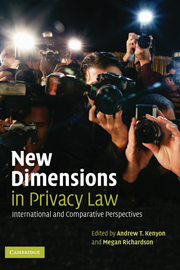Book contents
- Frontmatter
- Contents
- List of contributors
- Preface
- 1 New dimensions in privacy: Communications technologies, media practices and law
- 2 Privacy and freedom of speech
- 3 Revisiting the American action for public disclosure of private facts
- 4 The internet and private life in Europe: Risks and aspirations
- 5 APEC's privacy framework sets a new low standard for the Asia-Pacific
- 6 Copyright, privacy and digital rights management (DRM)
- 7 Why there will never be an English common law privacy tort
- 8 The ‘right’ of privacy in England and Strasbourg compared
- 9 Privacy and constitutions
- 10 Celebrity privacy and benefits of simple history
- Bibliography
- Index
- Index of laws and directives
- Index of case references
7 - Why there will never be an English common law privacy tort
Published online by Cambridge University Press: 24 July 2009
- Frontmatter
- Contents
- List of contributors
- Preface
- 1 New dimensions in privacy: Communications technologies, media practices and law
- 2 Privacy and freedom of speech
- 3 Revisiting the American action for public disclosure of private facts
- 4 The internet and private life in Europe: Risks and aspirations
- 5 APEC's privacy framework sets a new low standard for the Asia-Pacific
- 6 Copyright, privacy and digital rights management (DRM)
- 7 Why there will never be an English common law privacy tort
- 8 The ‘right’ of privacy in England and Strasbourg compared
- 9 Privacy and constitutions
- 10 Celebrity privacy and benefits of simple history
- Bibliography
- Index
- Index of laws and directives
- Index of case references
Summary
ONCE AGAIN, A FALSE DAWN. Stars linger in the sky, while an expectant band of terrestrial stars – pop stars, sports stars, stars of screen, radio, television, and the catwalk – accepts defeat, their dejection matched only by the misery of their lawyers. Few need be retold the tale of the English common law's failure to recognise, along American lines, a privacy tort (or torts), and I shall not repeat it here. My present purpose is to attempt to explain this unhappy state of affairs. Unhappy, because – despite the celestial image sketched above – the private lives of ‘ordinary’ individuals are equally vulnerable to unwanted publicity and warrant legal protection.
A common law privacy tort has been long in gestation. For almost four decades, the courts have danced around the problem. Numerous cases involving celebrities have been pleaded, mostly unsuccessfully, in equity as breaches of confidence, and, while the relationship between this remedy and a tort of privacy has been widely acknowledged, the highest court again has been presented with an opportunity to declare what the law is. In the interim, the enactment of the Data Protection Act 1998, and especially the Human Rights Act 1998, have served as significant catalysts for a final reckoning. The latter (which came into effect on 2 October 2000) has exercised a considerable influence on the judicial deliberation of privacy issues.
- Type
- Chapter
- Information
- New Dimensions in Privacy LawInternational and Comparative Perspectives, pp. 154 - 183Publisher: Cambridge University PressPrint publication year: 2006
- 2
- Cited by

